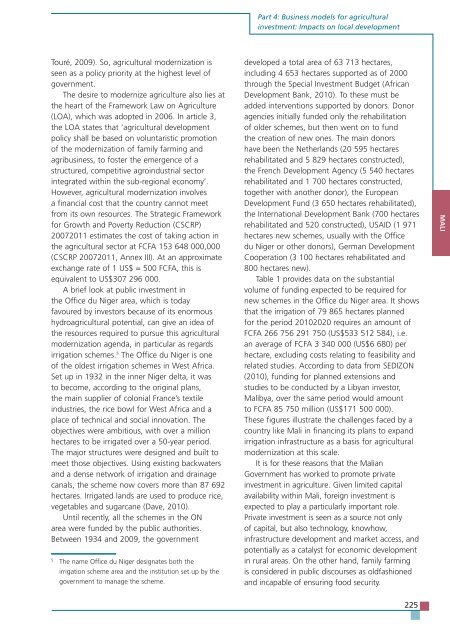TRENDS AND IMPACTS OF FOREIGN INVESTMENT IN DEVELOPING COUNTRY AGRICULTURE
TRENDS AND IMPACTS OF FOREIGN INVESTMENT IN DEVELOPING COUNTRY AGRICULTURE
TRENDS AND IMPACTS OF FOREIGN INVESTMENT IN DEVELOPING COUNTRY AGRICULTURE
Create successful ePaper yourself
Turn your PDF publications into a flip-book with our unique Google optimized e-Paper software.
Touré, 2009). So, agricultural modernization is<br />
seen as a policy priority at the highest level of<br />
government.<br />
The desire to modernize agriculture also lies at<br />
the heart of the Framework Law on Agriculture<br />
(LOA), which was adopted in 2006. In article 3,<br />
the LOA states that ‘agricultural development<br />
policy shall be based on voluntaristic promotion<br />
of the modernization of family farming and<br />
agribusiness, to foster the emergence of a<br />
structured, competitive agroindustrial sector<br />
integrated within the sub-regional economy’.<br />
However, agricultural modernization involves<br />
a financial cost that the country cannot meet<br />
from its own resources. The Strategic Framework<br />
for Growth and Poverty Reduction (CSCRP)<br />
20072011 estimates the cost of taking action in<br />
the agricultural sector at FCFA 153 648 000,000<br />
(CSCRP 20072011, Annex III). At an approximate<br />
exchange rate of 1 US$ = 500 FCFA, this is<br />
equivalent to US$307 296 000.<br />
A brief look at public investment in<br />
the Office du Niger area, which is today<br />
favoured by investors because of its enormous<br />
hydroagricultural potential, can give an idea of<br />
the resources required to pursue this agricultural<br />
modernization agenda, in particular as regards<br />
irrigation schemes. 5 The Office du Niger is one<br />
of the oldest irrigation schemes in West Africa.<br />
Set up in 1932 in the inner Niger delta, it was<br />
to become, according to the original plans,<br />
the main supplier of colonial France’s textile<br />
industries, the rice bowl for West Africa and a<br />
place of technical and social innovation. The<br />
objectives were ambitious, with over a million<br />
hectares to be irrigated over a 50-year period.<br />
The major structures were designed and built to<br />
meet those objectives. Using existing backwaters<br />
and a dense network of irrigation and drainage<br />
canals, the scheme now covers more than 87 692<br />
hectares. Irrigated lands are used to produce rice,<br />
vegetables and sugarcane (Dave, 2010).<br />
Until recently, all the schemes in the ON<br />
area were funded by the public authorities.<br />
Between 1934 and 2009, the government<br />
5 The name Office du Niger designates both the<br />
irrigation scheme area and the institution set up by the<br />
government to manage the scheme.<br />
Part 4: Business models for agricultural<br />
investment: Impacts on local development<br />
developed a total area of 63 713 hectares,<br />
including 4 653 hectares supported as of 2000<br />
through the Special Investment Budget (African<br />
Development Bank, 2010). To these must be<br />
added interventions supported by donors. Donor<br />
agencies initially funded only the rehabilitation<br />
of older schemes, but then went on to fund<br />
the creation of new ones. The main donors<br />
have been the Netherlands (20 595 hectares<br />
rehabilitated and 5 829 hectares constructed),<br />
the French Development Agency (5 540 hectares<br />
rehabilitated and 1 700 hectares constructed,<br />
together with another donor), the European<br />
Development Fund (3 650 hectares rehabilitated),<br />
the International Development Bank (700 hectares<br />
rehabilitated and 520 constructed), USAID (1 971<br />
hectares new schemes, usually with the Office<br />
du Niger or other donors), German Development<br />
Cooperation (3 100 hectares rehabilitated and<br />
800 hectares new).<br />
Table 1 provides data on the substantial<br />
volume of funding expected to be required for<br />
new schemes in the Office du Niger area. It shows<br />
that the irrigation of 79 865 hectares planned<br />
for the period 20102020 requires an amount of<br />
FCFA 266 756 291 750 (US$533 512 584), i.e.<br />
an average of FCFA 3 340 000 (US$6 680) per<br />
hectare, excluding costs relating to feasibility and<br />
related studies. According to data from SEDIZON<br />
(2010), funding for planned extensions and<br />
studies to be conducted by a Libyan investor,<br />
Malibya, over the same period would amount<br />
to FCFA 85 750 million (US$171 500 000).<br />
These figures illustrate the challenges faced by a<br />
country like Mali in financing its plans to expand<br />
irrigation infrastructure as a basis for agricultural<br />
modernization at this scale.<br />
It is for these reasons that the Malian<br />
Government has worked to promote private<br />
investment in agriculture. Given limited capital<br />
availability within Mali, foreign investment is<br />
expected to play a particularly important role.<br />
Private investment is seen as a source not only<br />
of capital, but also technology, knowhow,<br />
infrastructure development and market access, and<br />
potentially as a catalyst for economic development<br />
in rural areas. On the other hand, family farming<br />
is considered in public discourses as oldfashioned<br />
and incapable of ensuring food security.<br />
225<br />
MALI


